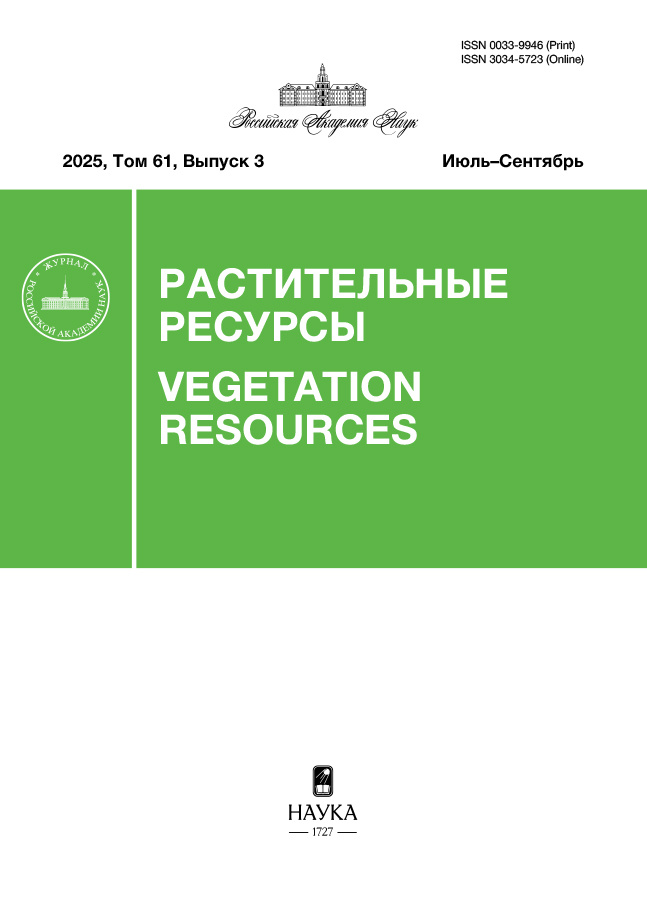Flavonoids of Cirsium vlassovianum (Asteraceae)
- 作者: Myagchilov A.V.1,2, Kalinin A.I.1, Sokolova L.I.1, Boyko E.V.2
-
隶属关系:
- Far Eastern Federal University
- G. B. Elyakov Pacific Institute of Bioorganic Chemistry FEB RAS
- 期: 卷 61, 编号 3 (2025)
- 页面: 114-118
- 栏目: Component Composition of Resource Species
- URL: https://kld-journal.fedlab.ru/0033-9946/article/view/695435
- DOI: https://doi.org/10.7868/S3034572325030081
- EDN: https://elibrary.ru/ygnzis
- ID: 695435
如何引用文章
详细
Currently, special attention is paid to plants of the genus Cirsium Mill. (Asteraceae) used in traditional medicine as medicinal raw materials with antibacterial, nootropic and anti-inflammatory properties. In addition, Cirsium species are used in folk medicine as anti-ulcer and vulnerary agents. The therapeutic properties of these plants are due to the content of phenolic compounds, especially flavonoids. Cirsium vlassovianum Fisch. ex DC., is one of the poorly studied plants growing in the Russian Far East, the flavonoid composition of which has not been examined. Three flavonoids were isolated from the aboveground part of C. vlassovianum by extraction, column chromatography, and RP-HPLC methods: hispidulin (1), hispidulin-7-O-β-glucopyranoside (2), and pectolinarin (3). The structure of the isolated compounds was confirmed by NMR-spectroscopy. By the method of RP-HPLC—MS/MS in the initial alcoholic extract of C. vlassovianum, six more flavonoids were identified: rutin (4), cynaroside (5), apigenin-7-O-β-glucuronopyranoside (6), apigenin (7), kaempferol (8), isokaempferide (9). Therefore, this plant can be a promising source of biologically active compounds.
作者简介
A. Myagchilov
Far Eastern Federal University; G. B. Elyakov Pacific Institute of Bioorganic Chemistry FEB RAS
编辑信件的主要联系方式.
Email: dfdfdf47@yandex.ru
Vladivostok, Russia; Vladivostok, Russia
A. Kalinin
Far Eastern Federal University
Email: dfdfdf47@yandex.ru
Vladivostok, Russia
L. Sokolova
Far Eastern Federal University
Email: dfdfdf47@yandex.ru
Vladivostok, Russia
E. Boyko
G. B. Elyakov Pacific Institute of Bioorganic Chemistry FEB RAS
Email: dfdfdf47@yandex.ru
Vladivostok, Russia
参考
- Тараховский Ю. С., Ким Ю. А., Абдрасилов Б. С., Музафаров Е. Н. 2013. Флавоноиды: биохимия, биофизика, медицина. Пущино. 310 с. http://biophenols.ru/wp/wp-content/uploads/2013/11/Tarahovsky.pdf (дата обращения 18.05.2025)
- Растительные ресурсы России: Дикорастущие цветковые растения, их компонентный состав и биологическая активность. 2013. Т. 5. Семейство Asteraceae (Compositae). СПб.; М. 312 с.
- Kim H. H., Jeong S. H., Park M. Y., Bhosale P. B., Abusaliya A., Kim H. W., Seong J. K., Kim D. I., Lee S. J., Park K. I., Kim G. S. 2024. Potential antioxidant and anti-inflammatory properties of polyphenolic compounds from Cirsium japonicum extract. — Int. J. Mol. Sci. 25(2): 785. https://doi.org/10.3390/ijms25020785
- Nazaruk J., Chłędzik S., Strawa J., Bazydło K., Wajs-Bonikowska A. 2017. Chemical composition and antioxidant activity of Cirsium vulgare inflorescences. — Nat. Prod. Commun. 12(4): 519—522. https://doi.org/10.1177/1934578X1701200414
- Griškevičienė U., Marksa M., Ževžikovienė A., Kazlauskienė D., Vainorienė R., Ževžikovas A., Ivanauskas L. 2021. Cirsium vulgare leaves: isolation and identification of phenolic compounds. — Chemija. 32(3—4): 92—99. http://doi.org/10.6001/chemija.v32i3-4.4547
- Kozyra M., Biernasiuk A., Malm A., Chowaniec M. 2015. Chemical compositions and antibacterial activity of extracts obtained from the inflorescences of Cirsium canum (L.) All. — Natural Product. Research. 29(21): 2059—2063. http://doi.org/10.1080/14786419.2015.1030341
- Nazaruk J., Czechowska S. K., Markiewicz R., Borawska M. H. 2008. Polyphenolic compounds and in vitro antimicrobial and antioxidant activity of aqueous extracts from leaves of some Cirsium species. — Nat. Prod. Res. 22(18): 1583—1588. https://doi.org/10.1080/14786410701825053
- Loizzo M. R., Statti G., Tundis R., Conforti F., Ando S., Menichini F. 2004. Antimicrobial activity and cytotoxicity of Cirsium tenoreanum. — Fitoterapia. 75(6): 577—580. https://doi.org/10.1016/j.fitote.2004.03.011
- Hase T., Ohtani K., Kasai R., Yamasaki K., Picheansoonthon Ch. 1995. Revised structure for hortensin, a flavonoid from Millingtonia hortensis. — Phytochemistry. 40(1): 287—290. https://doi.org/10.1016/0031-9422(95)00206-M
- Ye Y., Chen Z., Wu Y., Gao M., Zhu A., Kuai X., Luo D., Chen Y., Li K. 2022. Purification process and in vitro and in vivo bioactivity evaluation of pectolinarin and linarin from Cirsium japonicum. — Molecules. 27(24): 8695. http://doi.org/10.3390/molecules27248695
- Lopez-Lazaro M. 2009. Distribution and biological activities of the flavonoid luteolin. — Mini Rev. Med. Chem. 9(1): 31—59. http://doi.org/10.2174/138955709787001712
补充文件









